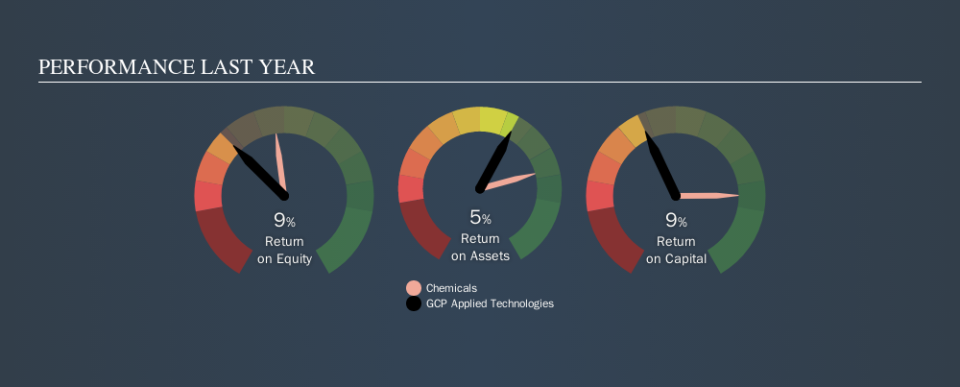How Good Is GCP Applied Technologies Inc. (NYSE:GCP) At Creating Shareholder Value?

Today we are going to look at GCP Applied Technologies Inc. (NYSE:GCP) to see whether it might be an attractive investment prospect. Specifically, we'll consider its Return On Capital Employed (ROCE), since that will give us an insight into how efficiently the business can generate profits from the capital it requires.
First up, we'll look at what ROCE is and how we calculate it. Then we'll compare its ROCE to similar companies. Finally, we'll look at how its current liabilities affect its ROCE.
Understanding Return On Capital Employed (ROCE)
ROCE is a metric for evaluating how much pre-tax income (in percentage terms) a company earns on the capital invested in its business. In general, businesses with a higher ROCE are usually better quality. Overall, it is a valuable metric that has its flaws. Renowned investment researcher Michael Mauboussin has suggested that a high ROCE can indicate that 'one dollar invested in the company generates value of more than one dollar'.
So, How Do We Calculate ROCE?
Analysts use this formula to calculate return on capital employed:
Return on Capital Employed = Earnings Before Interest and Tax (EBIT) ÷ (Total Assets - Current Liabilities)
Or for GCP Applied Technologies:
0.09 = US$94m ÷ (US$1.3b - US$222m) (Based on the trailing twelve months to June 2019.)
So, GCP Applied Technologies has an ROCE of 9.0%.
Check out our latest analysis for GCP Applied Technologies
Is GCP Applied Technologies's ROCE Good?
ROCE can be useful when making comparisons, such as between similar companies. Using our data, GCP Applied Technologies's ROCE appears to be around the 10% average of the Chemicals industry. Aside from the industry comparison, GCP Applied Technologies's ROCE is mediocre in absolute terms, considering the risk of investing in stocks versus the safety of a bank account. Investors may wish to consider higher-performing investments.
GCP Applied Technologies's current ROCE of 9.0% is lower than its ROCE in the past, which was 23%, 3 years ago. This makes us wonder if the business is facing new challenges. You can see in the image below how GCP Applied Technologies's ROCE compares to its industry. Click to see more on past growth.
When considering ROCE, bear in mind that it reflects the past and does not necessarily predict the future. Companies in cyclical industries can be difficult to understand using ROCE, as returns typically look high during boom times, and low during busts. ROCE is, after all, simply a snap shot of a single year. Future performance is what matters, and you can see analyst predictions in our free report on analyst forecasts for the company.
How GCP Applied Technologies's Current Liabilities Impact Its ROCE
Current liabilities are short term bills and invoices that need to be paid in 12 months or less. Due to the way ROCE is calculated, a high level of current liabilities makes a company look as though it has less capital employed, and thus can (sometimes unfairly) boost the ROCE. To counter this, investors can check if a company has high current liabilities relative to total assets.
GCP Applied Technologies has total assets of US$1.3b and current liabilities of US$222m. Therefore its current liabilities are equivalent to approximately 17% of its total assets. It is good to see a restrained amount of current liabilities, as this limits the effect on ROCE.
The Bottom Line On GCP Applied Technologies's ROCE
That said, GCP Applied Technologies's ROCE is mediocre, there may be more attractive investments around. Of course, you might also be able to find a better stock than GCP Applied Technologies. So you may wish to see this free collection of other companies that have grown earnings strongly.
If you like to buy stocks alongside management, then you might just love this free list of companies. (Hint: insiders have been buying them).
We aim to bring you long-term focused research analysis driven by fundamental data. Note that our analysis may not factor in the latest price-sensitive company announcements or qualitative material.
If you spot an error that warrants correction, please contact the editor at editorial-team@simplywallst.com. This article by Simply Wall St is general in nature. It does not constitute a recommendation to buy or sell any stock, and does not take account of your objectives, or your financial situation. Simply Wall St has no position in the stocks mentioned. Thank you for reading.

 Yahoo Finance
Yahoo Finance 
